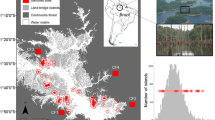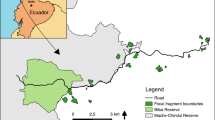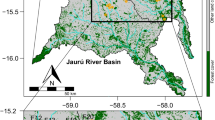Abstract
Tropical forest mammal assemblages are widely affected by the twin effects of habitat loss and habitat fragmentation. We evaluated the effects of forest patch metrics, habitat structure, age of patch isolation, and landscape metrics on the species richness, abundance and composition of small mammals at 23 forest fragments (ranging in size from 43 to 7,035 ha) in a highly deforested 3,609-km2 landscape of southwestern Brazilian Amazonia. Using pitfall traps and both terrestrial and arboreal traplines of Sherman, Tomahawk and snap traps, we captured a total of 844 individuals over 34,900 trap-nights representing 26 species and 20 genera of small-mammals, including 13 rodent and 13 marsupial species. We also consider the effects of distance from forest edges on species occupancy and abundance. Overall small mammal abundance, species richness and species composition were primarily affected by the quality of the open-habitat matrix of cattle pastures, rather than by patch metrics such as fragment size. Ultimately, small mammal community structure was determined by a combination of both landscape- and patch-scale variables. Knowledge of the anthropogenic factors that govern small mammal community structure is of critical importance for managing the persistence of forest vertebrates in increasingly fragmented neotropical forest landscapes.







Similar content being viewed by others
References
Amaral DL, Fonzar BC (1982) Levantamento de recursos naturais. In: RADAMBRASIL—Folha SD 21. Cuiabá—Rio de Janeiro. MME
Bergallo HG, Magnusson WE (1999) Effects of climate and food availability on four rodent species in southeastern Brazil. J Mammal 80:472–486
Broadbent EN, Asner GP, Keller M, Knapp DE, Oliveira PJC, Silva JN (2008) Forest fragmentation and edge effects from deforestation and selective logging in the Brazilian Amazon. Biol Conserv 141:1745–1757
Burnham KP, Anderson DR (2002) Model selection and multimodel inference: a practical information-theoretic approach. Springer, New York
Calcagno V (2010) glmulti: GLM model selection and multimodel inference made easy. R package version 0.6-3. http://CRAN.R-project.org/package=glmulti
Chiarello AG (1999) Effects of fragmentation of the Atlantic forest on mammal communities in south-eastern Brazil. Biol Conserv 89:71–82
Chiarello AG (2000) Conservation value of a native forest fragment in a region of extensive agriculture. Braz J Biol 60:237–247
Clarke KR, Warwick RM (2001) Change in marine communities: an approach to statistical analysis and interpretation, 2nd edn. Primer-E Ltd, Plymouth
Código Florestal (2001) Código Florestal Brasileiro. Instituto Brasileiro de Desenvolvimento Florestal, Ministério da Agricultura, Brasília. [www.document]. URL http://www.planalto.gov.br/CCIVIL/Leis/L4771.htm
Colwell RK (1997) Programa EstimateS, version 5: Statistical estimation of species richness and shared species from samples. User’s Guide and application published at: http://viceroy.eeb.uconn.edu/estimates
De Castro EBV, Fernandez FAS (2004) Determinants of differential extinction vulnerabilities of small mammals in Atlantic forest fragments in Brazil. Biol Conserv 119:73–80
Emmons LH, Feer F (1997) Neotropical rainforest mammals: a field guide, 2nd edn. University of Chicago Press, Chicago, p 307
Fernandes MEB, Andrade FAG, Silva-Júnior SJ (2006) Dieta de Micoureus demerarae (Thomas) (Mammalia, Didelphidae) associada às florestas contíguas de mangue e terra firme em Bragança, Pará, Brasil. Revista Brasileira de Zoologia 23:1087–1092
Figueiredo MSL, Fernandez FAS (2004) Contrasting effects of fire on populations of two small rodent species in fragments of Atlantic Forest in Brazil. J Trop Ecol 20:225–228
Fonseca GAB, Robinson JG (1990) Forest size and structure: competitive and predatory effects on small mammal communities. Biol Conserv 53:265–294
Gascon C, Lovejoy TE, Bierregaard RO, Malcolm JR, Stouffer PC, Vasconcelos HL, Laurance WF, Zimmerman B, Toucher M, Borges S (1999) Matrix habitat and species richness in tropical forest remmants. Biol Conserv 91:223–229
Goodman SM, Rakotondravony D (2000) The effects of forest fragmentation and isolation on insectivorous small mammals (Lipotyphla) on Central High Plateau of Madagascar. J Zool 250:193–200
Gotelli NJ, Colwell RK (2001) Quantifying biodiversity: procedures and pitfalls in the measurement and comparison of species richness. Ecol Lett 4:379–391
Gray TNE, Borey R, Hout SK, Chamnan H, Collar NJ, Dolman PM (2009) Generality of models that predict the distribution of species: conservation activity and reduction of model transferability for a threatened bustard. Conserv Biol 23:433–439
Laurance WF (2008) Theory meets reality: how habitat fragmentation research has transcended island biogeographic theory. Biol Conserv 141:1731–1744
Laurance WF, Peres CA (2006) Emerging threats to tropical forests. University of Chicago Press, Chicago
Laurance WF, Yensen’s E (1991) Predicting the impacts of edge effects in fragmented habitats. Biol Conserv 55:77–92
Laurance WF, Lovejoy TE, Vasconcelos HL, Bruna EM, Didhan RK, Stouffer PC, Gascon C, Bierregaard RO, Laurance SG, Sampaio E (2002) Ecosysten decay of Amazonian forest fragments: a 22-year investigation. Conserv Biol 16:605–618
Lees AC, Peres CA (2008) Avian Life history determinants of local extinction risk in a fragmented neotropical forest landscape. Anim Conserv 11:128–137
Lees AC, Peres CA (2009) Gap-crossing movements predict species occupancy in Amazonian forest fragments. Oikos 118:280–290
Lemmon PE (1957) A new instrument of measuring forest overstory density. J For 55:667–669
Malcolm JR (1991) The small mammals of Amazon forest fragments: Pattern and process. Ph.D. Thesis, University of Florida. Gainesville, Florida
Malcolm JR (1994) Edge effects in central Amazonian forest fragment. Ecology 75:2438–2445
Malcolm JR (1995) Forest structure and the abundance and diversity of neotropical small mammals. In: Lowmant MD, Nadkarni NM (eds) Forest canopies. Academic Press, San Diego
Malcolm JR (1997a) Biomass and diversity of small mammals in Amazonian forest fragments. In: Laurance WF, Bierregaard RO Jr (Eds) Tropical forest remnants, ecology, management, and conservation of fragmented communities. The University of Chicago Press, Chicago, pp 207–220
Malcolm JR (1997b) Insect biomass in Amazonian forest fragments. In: Stork NE, Adis J, Didham RK (eds) Can arthropods. Chapman and Hall, London, pp 510–533
Maldonado-Coelho M, Marini MÂ (1999) Effects of forest fragment size and successional stage on mixed-species bird flocks in Southeastern Brazil. The Condor 102:585–594
Mcgarigal K, Gushman SA, Neel MC, Ene E (2002) FRAGSTATS: Spatial Pattern Analysis Program for Categorical Maps. Computer software program produced by the authors at the University of Massachusetts, Amherst. Available at the following web site: www.umass.edu/landeco/research/fragstats/fragstats.html
MCT/CNPq (1985) Pesquisa ecológica na região do Polonoroeste. Brasília, DF
Michalski F, Peres CA (2007) Disturbance-mediated mammal abundance-area relationships in Amazonian forest fragments. Conserv Biol 21:1626–1640
Oliveira VA, Amaral Filho ZP, Vieira PC (1982) Levantamentos de Recursos Naturais. In: RADAMBRASIL—SD 21—Cuiabá—Rio de Janeiro. MME
Pardini R (2001) Pequenos mamíferos e a fragmentação da Mata Atlântica de Una, sul da Bahia: Processos e conservação. Dissertação de doutorado, Universidade de São Paulo, São Paulo
Pardini R (2004) Effects of Forest fragmentation on small mammals in na Atlantic forest landscape. Biodivers Conserv 13:2567–2586
Passamani M (2003) O Efeito da fragmentação da Mata Atlântica Serrana sobre a comunidade de pequenos mamíferos de Santa Teresa, Espírito Santo. Dissertação de Doutorado, Universidade Federal do Rio de Janeiro, RJ
Passamani M, Ribeiro D (2009) Small mammals in a fragment and adjacent matrix in southeastern Brazil. Braz J Biol 69:305–309
Peres CA, Gardner TA, Barlow J, Jansen J, Michalski F, Lees AC, Vieira ICG, Moreira FMD, Feeley K (2010) Biodiversity conservation in human-modified Amazonian forest landscapes. Biol Conserv 143:2314–2327
Pinheiro PS, Carvalho FMV, Fernandez FAS, Nessimian JL (2002) Diet of the marsupial Micoureus demerarae in small fragments of Atlantic Forest in southeastern Brazil. Stud Neotrop Fauna Environ 37:213–218
Pires AS, Lira PK, Fernandez FAF, Schittini GM, Oliveira LC (2002) Frequency of movements of small mammals among Atlantic Coastal forest fragments in Brazil. Biol Conserv 108:229–237
Resende MS, Sandanielo A, Couto EG (1994) Zoneamento agroecológico do sudoeste do estado de Mato Grosso. Documentos 4. EMPAER/EMBRAPA
Rittl CE (1998) Efeitos da extração seletiva de madeira sobre a comunidade de pequenos mamíferos de uma floresta de terra firme na Amazônia Central. Dissertação de Mestrado em Ecologia. INPA
Santos BA, Peres CA, Oliveira MA, Grillo A, Alves-Costa CP, Tabarelli M (2007) Drastic functional erosion of tree assemblage attributes in Atlantic forest fragments of northeastern Brazil. Biol Conserv 141:249–260
Santos-Filho M, Da Silva DJ, Sanaiotti TM (2006) Efficiency of four trap types in sampling small mammals in forest fragments, Mato Grosso, Brazil. Mastozoologia Neotropical 13:217–225
Santos-Filho M, Da Silva DJ, Sanaiotti TM (2008) Variação sazonal na riqueza e na abundância de pequenos mamíferos, na estrutura da floresta e na disponibilidade de artrópodes em fragmentos florestais no Mato Grosso, Brasil. Biota Neotropica, v8 (1):115–121
Scott DM, Brown D, Mahood S, Denton B, Silburn A, Rakotondraparany F (2005) The impacts of forest clearance on lizard, small mammals and bird communities in the arid spiny forest, southern Madagascar. Biol Conserv 127:72–87
Skole D, Tucker C (1993) Tropical deforestation and habitat fragmentation in the Amazon: satellite data from 1978 to 1988. Science 260:1905–1909
Stevens SM, Husband TP (1998) The influence of edge on small mammals: evidence from Brazilian Atlantic forest fragments. Biol Conserv 85:1–8
Tattersall FH, Macdonald DW, Hart BJ, Hohnson P, Manley W, Feber R (2002) Is habitat linearity important for small mammal communities on farmland? J Appl Ecol 39:643–652
Terborgh J (1992) Maintenance of diversity in tropical forests. Biotropica 24:283–292
Umetsu F, Pardini P (2007) Small mammals in a mosaic of forest remnants and anthropogenic habitats—evaluating matrix quality in an Atlantic forest landscape. Landsc Ecol 22:517–530
Vieira EM (1999) Small mammal communities and fire in the Brazilian Cerrado. J Zool 249:75–81
Whittingham MJ, Swetnam RD, Wilson JD, Chamberlain DE, Freckleton RP (2005) Habitat selection by yellowhammers Emberiza citrinella on lowland farmland at two spatial scales: implications for conservation management. J Appl Ecol 42:270–280
Yahner RH (1988) Changes in wildlife communities near edges. Conserv Biol 2:333–339
Acknowledgments
This study was funded by a Brazilian Ministry of Education (CAPES) doctoral studentship to MSF at the Instituto Nacional de Pesquisas da Amazônia (INPA, Manaus). We would like to thank all landowners for permission to work within their landholdings. William Magnusson, Renato Cintra, Jay Malcolm and an anonymous reviewer provided useful comments on the manuscript. This study was conducted under IBAMA research permits 033/02, 004/03 and 057/04.
Author information
Authors and Affiliations
Corresponding author
Rights and permissions
About this article
Cite this article
Santos-Filho, M., Peres, C.A., da Silva, D.J. et al. Habitat patch and matrix effects on small-mammal persistence in Amazonian forest fragments. Biodivers Conserv 21, 1127–1147 (2012). https://doi.org/10.1007/s10531-012-0248-8
Received:
Accepted:
Published:
Issue Date:
DOI: https://doi.org/10.1007/s10531-012-0248-8




